|
The United States Coast
Guard
World War II
.
The US Coast Guard remained part of the United
States Treasury Department throughout World War II.
However, a month before America formally entered
the war, President Roosevelt transferred the entire Coast Guard to Navy
control. Known as Executive Order 8929, it was signed 1 November 1941.
Thus, the US Coast Guard was a distinctive
part of the Navy throughout World War II until 1 January 1946. |
.v |
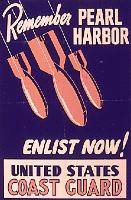 |
.
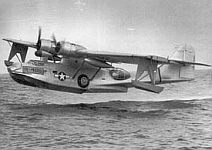
Consolidated PBY-5A / 6A "Catalina"
A majority of the Catalina flying
boats operated air/sea rescue.
|
.v |
The foremost Coast Guard wartime mission was
protecting America’s extensive sea frontier and long coastlines, which
was primarily accomplished with picket boats and patrol craft assisted
by aircraft of the Coast Guard air arm. German submarines menaced this
area and the Coast Guard rescued thousands of survivors of torpedoed ships.
These rescues were accomplished despite high surf and rip currents, frigid
and often storm-tossed Atlantic waves, and the blazing oil fires of stricken
freighters and tanker ships. |
.
Throughout the war, the Coast Guard continued
high-risk chores related to the safety of lives and property at sea. It
rescued countless distressed ships, many crippled by enemy action, on the
high seas despite dense fog and fierce storms.
.
| The expansion of the Coast Guard and release
of more men for the front by the women SPARS, and other reserve and auxiliary
volunteers, enabled the service to take the fight to the enemy. By June
1945, the Coast Guard operated 802 of its own ships with 24,342 Coast Guard
personnel, 288 Navy ships with Coast Guard crews totaling 49,283 personnel,
and 262 Army ships with 6,851 Coast Guard crewmembers. These crews included
Public Health Service nurses and medical doctors. |
.v |
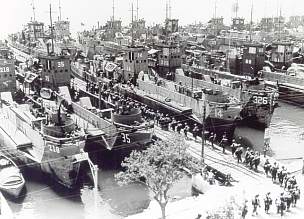 Troops boarding Coast Guard-manned
vessels for the invasion of Sicily in July, 1943.
Troops boarding Coast Guard-manned
vessels for the invasion of Sicily in July, 1943.
|
.
The ships ranged from destroyer escorts, Coast
Guard cutters, transport ships, cargo ships, attack transport ships and
gasoline tanker ships. Others ranged from patrol frigates to landing ships
and craft of every type and description.
.
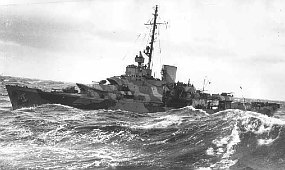 The Coast Guard crack cutter
Duane
on anti-sub patrol in the North Atlantic.
The Coast Guard crack cutter
Duane
on anti-sub patrol in the North Atlantic.
|
.v |
The antisubmarine campaign against U-boats,
during the great Battle of the Atlantic, was the most important Coast Guard
combat task until Germany’s surrender (when emphasis shifted to defeating
the Japanese in the Pacific). The Coast Guard relentlessly hunted and attacked
enemy submarines around Greenland and the Arctic Circle, the North and
South Atlantic Oceans, and in the Mediterranean and Caribbean Seas. |
.
The Coast Guard shepherded convoys with its
destroyer escorts and cutters. These were small enough and lightly armed
to enable U-boats to fight them on an individual basis. The Coast Guard
lost 32 of its ships during this campaign, but sunk twelve U-boats. Eleven
German submarines were destroyed by Coast Guard destroyers and cutters,
and another was sunk by a Coast Guard aircraft.
.
| The small-boat handling proficiency of Coast
Guardsmen, who were often recruited from civilian roles with sea experience
(such as professional fishermen, amateur sailors and lifeboat rowers),
led to the service being given priority for steering landing ships and
utility craft during beach invasions. |
.v |
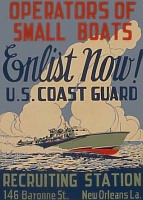 |
.
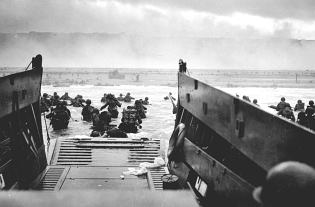 Disembarking Army troops from
the Coast Guard-manned LCVP (Landing Craft, Vehicle
and Personnel) of the USS Samuel Chase (Omaha Beach, 6 June
1944)
Disembarking Army troops from
the Coast Guard-manned LCVP (Landing Craft, Vehicle
and Personnel) of the USS Samuel Chase (Omaha Beach, 6 June
1944)
|
.v |
The Coast Guardsmen bravely landed Army troops
on hostile beaches in North Africa, Sicily, Italy, France and the Pacific
despite direct enemy fire that swept the incoming assault boats.
At the same time, they also performed daring
rescues. 1,660 Army soldiers were saved from drowning by Coast Guard expert
swimmers during the invasion of Normandy alone. |
.
In these dangerous beach assaults, the small
landing craft were often blown apart by enemy cannon, mortars and heavy
machineguns, which unfortunately caused high Coast Guard casualties. The
US Coast Guard participated in every single amphibious operation conducted
by the United States during World War II.
.
| The Coast Guard was also responsible for the
protection of the American coasts during World War II. The service regrouped
its shore stations and lifeboat teams to create the Beach Patrol for this
purpose during 1942.
Due to their good senses of smelling and hearing
and their ability to be trained for guard duty, the Coast Guard started
to use dogs for patrol duty in 1942. |
.v |
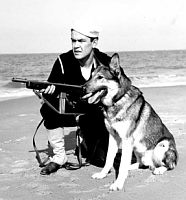 Dog Beach Patrol in 1943 on
Parramore Beach
Dog Beach Patrol in 1943 on
Parramore Beach
|
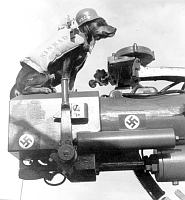 |
.. |
Right: A Walt Disney cartoon
from 1945 featuring Pluto was dedicated to the patrol dogs of the U.S.
Coast Guard. It shows Pluto as a member of the Coast Guard who tries to
keep a newborn turtle from off-limits beach territory.
Left: Dog"Sindbad" was the
maskot of the Coast Guard. This dog who accompanied the crew of the combat
cutter Campbell during the war became quite famous. |
.. |
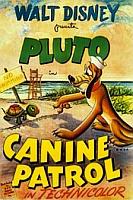 |
| Another critical Coast Guard task was port
security. In addition to protection of waterfront property and ship facilities,
the Coast Guard also supervised the swift turnaround of shipping, so that
ship delays were minimized and port congestion was avoided. The smooth
flow of ships in and out of harbors and other anchorages, as well as the
overall safe handling of ammunition (despite some tragic accidents), were
Coast Guard triumphs. Most port safety and supervisory tasks were eventually
performed by SPARS women and temporary reservists, as more and more Coast
Guardsmen were sent to sea. |
.v |
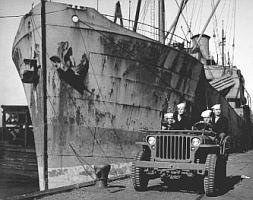
A Coast Guard port security patrol
in New York |
.
The US Coast Guard in World War II contributed
greatly to allied victory. On 1 January 1946, it was returned to the Treasury
Department for routine peacetime duty by a grateful nation.
.
.
[ I. Development ]..[
II. Facts about the SPARS ]..[
III. Uniforms ]..[
IV. Sources ]
|
